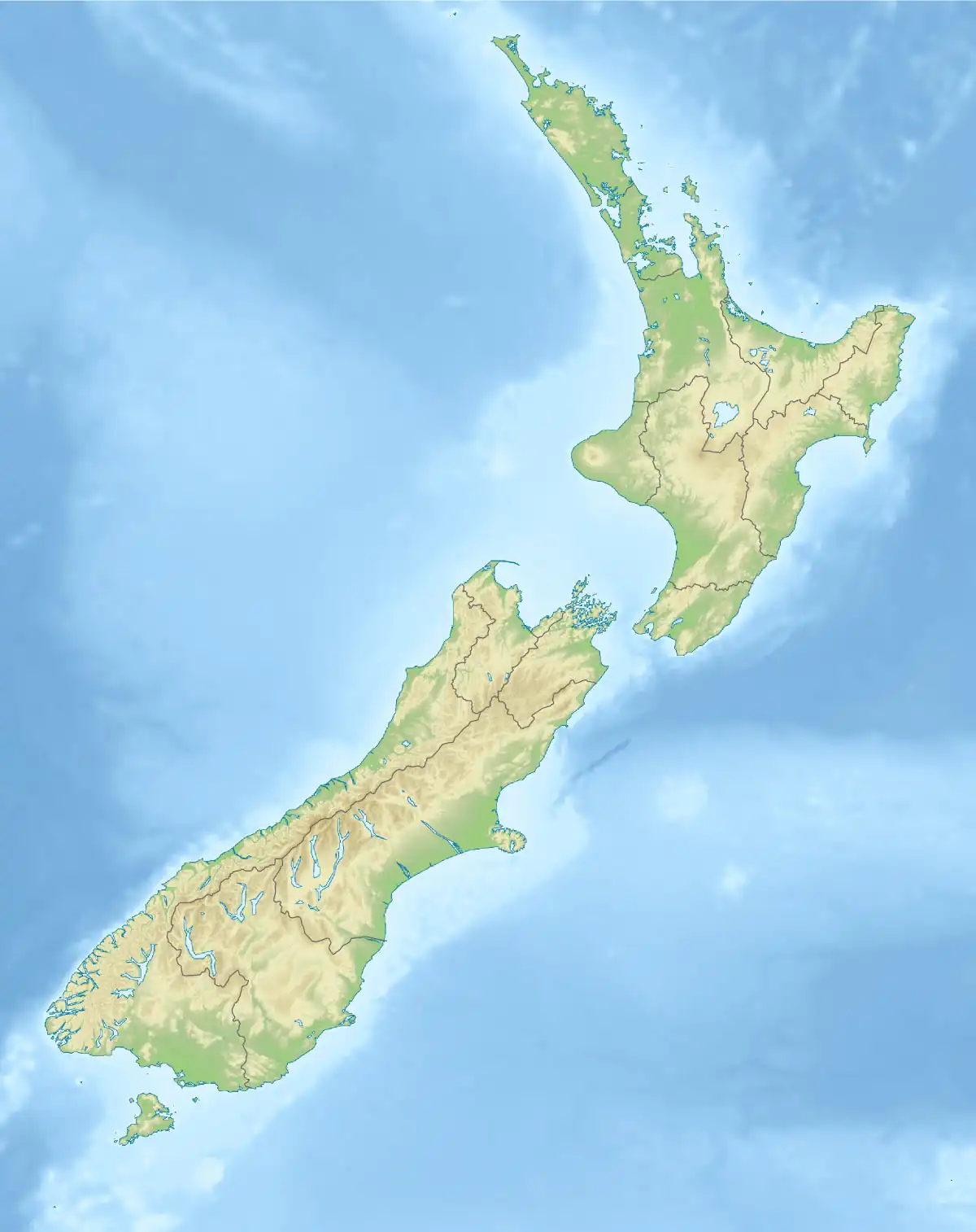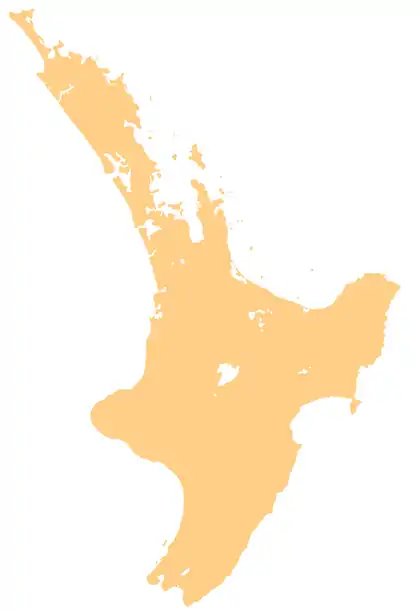Rotoiti Caldera
The Rotoiti Caldera is a postulated,[1] mainly infilled sub caldera of the Ōkataina Caldera based upon gravitational and magnetic evidence.[2] It erupted 100 cubic kilometres (24 cu mi) of magma[3] that is used in the recent stratigraphy of much of the northern North Island.[4][5][6][7][8] It was formed in the larger paired eruption with the lesser Earthquake Flat vents linked by tectonic interaction across the length of the Ōkataina Caldera.[9][3] The series of eruptions was about 50,000 years ago, with the resulting widespread Rotoiti ignimbrite and several layers of Rotoiti/Rotoehu tephra/brecca/ash giving challenges in consistent dating.[10][11][12][Notes 1] It was subsequently infilled by later eruptive activity to a depth of over 2 km (1.2 mi).[2] The paired eruptions may have erupted about 240 cubic kilometres (58 cu mi) of tephra.[13]
| Rotoiti Caldera | |
|---|---|
| Ōkataina Caldera, Okataina Caldera, Haroharo Caldera | |
| Highest point | |
| Coordinates | 38°10′S 176°30′E |
| Dimensions | |
| Length | 15 km (9.3 mi) |
| Width | 15 km (9.3 mi) |
| Geography | |
 Rotoiti Caldera  Rotoiti Caldera Rotoiti Caldera (North Island) | |
| Country | New Zealand |
| Region | Bay of Plenty |
| Geology | |
| Age of rock | approximately 50,000 years |
| Mountain type | Caldera |
| Volcanic region | Taupō Volcanic Zone |
Notes
- Ages assigned to the Rotoiti/Rotoehu eruptives currently appear to vary depending upon methodology by about 15,000 years in the literature. This is problematic as many ages of volcanics in the Northern North Island would be more definite if a single agreed value existed. The issue of previous inaccurate age assignment started with a new figure for Rotoehu Ash of 64,000 ± 1650 cal.yr.(Wilson et al 1992) which was initially widely accepted. The youngest age assigned is 44,300 years ago (Shane et al 2003). The problems with some older techniques were possibly not resolved with new techniques that could explain the discrepancy and that resulted in 47,400 ± 1500 years ago (Flude et al 2016), as one recent peer reviewed work gave 61,000 ± 1400 cal.yr (Villamor et al 2022). Other chronology studies have a younger date of 45,200 ± 1650 cal.yr. (Danišík et al 2020 and 2012), 47,400 ± 1500 years ago (Gilgour et al 2008), and before these 65,000 years ago (Spinks 2005). For more on this age issue see notes to Puhipuhi Embayment.
References
- Cole, J. W.; Spinks, K. D. (2009). "Caldera volcanism and rift structure in the Taupo Volcanic Zone, New Zealand". Special Publications. London: Geological Society. 327 (1): 9–29. Bibcode:2009GSLSP.327....9C. doi:10.1144/SP327.2. S2CID 131562598.
- Hughes, Ery C.; Law, Sally; Kilgour, Geoff; Blundy, Jon D.; Mader, Heidy M. (2023). "Storage, evolution, and mixing in basaltic eruptions from around the Okataina Volcanic Centre, Taupō Volcanic Zone, Aotearoa New Zealand". Journal of Volcanology and Geothermal Research. 434 (107715). doi:10.1016/j.jvolgeores.2022.107715. ISSN 0377-0273.
- Shane, Phil; Nairn, I.A.; Smith, Victoria C. (2005). "Magma mingling in the ~50 ka Rotoiti eruption from Okataina Volcanic Centre: Implications for geochemical diversity and chronology of large volume rhyolites". Journal of Volcanology and Geothermal Research. 139 (3–4): 295–313. Bibcode:2005JVGR..139..295S. doi:10.1016/j.jvolgeores.2004.08.012.
- Gilgour, G.N.; Smith, R.T. (2008). "Stratigraphy, dynamics, and eruption impacts of the dual magma Rotorua eruptive episode, Okataina Volcanic Centre, New Zealand" (PDF). New Zealand Journal of Geology & Geophysics. 51 (4): 367–378. doi:10.1080/00288300809509871. S2CID 128976717.
- Spinks, Karl D. (2005). Rift Architecture and Caldera Volcanism in the Taupo Volcanic Zone, New Zealand (Thesis).
- Flude, S.; Storey, M. (2016). "40Ar/39Ar age of the Rotoiti Breccia and Rotoehu Ash, Okataina Volcanic Complex, New Zealand, and identification of heterogeneously distributed excess 40Ar in supercooled crystals". Quaternary Geochronology. 33: 13–23. doi:10.1016/j.quageo.2016.01.002.
- Danišík, Martin; Lowe, David J.; Schmitt, Axel K.; Friedrichs, Bjarne; Hogg, Alan G.; Evans, Noreen J. (2020). "Sub-millennial eruptive recurrence in the silicic Mangaone Subgroup tephra sequence, New Zealand, from Bayesian modelling of zircon double-dating and radiocarbon ages" (PDF). Quaternary Science Reviews. 246. doi:10.1016/j.quascirev.2020.106517. ISSN 0277-3791.
- Villamor, Pilar; Litchfield, Nicola J.; Gómez-Ortiz, David; Martin-González, Fidel; Alloway, Brent V.; Berryman, Kelvin R.; Clark, Kate J.; Ries, William F.; Howell, Andrew; Ansell, India A. (2022). "Fault ruptures triggered by large rhyolitic eruptions at the boundary between tectonic and magmatic rift segments: The Manawahe Fault, Taupō Rift, New Zealand". Journal of Volcanology and Geothermal Research. 427. doi:10.1016/j.jvolgeores.2022.107478. ISSN 0377-0273.
- Houghton B F, Wilson C J N, McWilliams M O, Lanphere M A, Weaver S D, Briggs R M, Pringle M S, 1995. Chronology and dynamics of a large silicic magmatic system: Central Taupo Volcano Zone, New Zealand. Geology, 23: 13-16.
- Wilson, C. J. N.; Houghton, B. F.; Lamphere, M. A.; Weaver, S. D. (1992). "A new radiometric age estimate for the Rotoehu Ash from Mayor Island volcano, New Zealand". New Zealand Journal of Geology and Geophysics. 35: 371–374. doi:10.1080/00288306.1992.9514530.
- Shane, P.; Sandiford, A. (2003). "Paleovegetation of marine isotope stages 4 and 3 in Northern New Zealand and the age of the widespread Rotoehu tephra". Quaternary Research. 59 (3): 420–429. doi:10.1016/S0033-5894(03)00044-9.
- Schmitz, Mark D.; Smith, Ian E. M. (2004). "The Petrology of the Rotoiti Eruption Sequence, Taupo Volcanic Zone: an Example of Fractionation and Mixing in a Rhyolitic System". Journal of Petrology. 45 (10): 2045–2066. doi:10.1093/petrology/egh047.
- Froggatt, P. C. & Lowe, D. J. (1990). "A review of late Quaternary silicic and some other tephra formations from New Zealand: their stratigraphy, nomenclature, distribution, volume, and age". New Zealand Journal of Geology and Geophysics. 33: 89–109. doi:10.1080/00288306.1990.10427576.